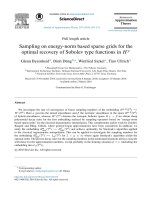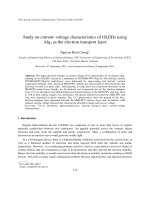DSpace at VNU: Note on the Asymptotic Stability of Solutions of Differential Systems
Bạn đang xem bản rút gọn của tài liệu. Xem và tải ngay bản đầy đủ của tài liệu tại đây (2.28 MB, 7 trang )
V N U . J O U R N A L O F S C IE N C E , M a t h e m a tic s - Physics.
T.xx,
N q 3 - 2004
N O TE ON TH E A S Y M P T O T IC ST A B IL IT Y OF
SOLUTIONS OF D IF F E R E N T IA L S Y S T E M S
D a o T h i L ie n
Thai Nguyen Teacher Training College
A b s t r a c t . We shall discuss the asymptotic behavior of solutions of differential systems.
Some new notions of stability and examples will be given and some stability conditions
will be proved.
Consider the differential system
Ỉ =x(t ’x)
(1)
X ( t , 0 ) = 0 , t e I = [a, + oo), a > 0 ,
where X G R n , D = {(£, x) I t 6 / , ||x|| < H , } H > 0 and suppose th a t function
X :
D— » R n
(t, x) I— >X ( t , x)
is continuous and satisfies condit ion of uniqueness of solution in D. T h e re is a vast literature
on the theory and applications of L iapu no v’s second m eth od (see, for example, [1], [2], [3],
[4], [5], [GJ, [7], [8 ], [9]). Here we shall discuss on the ” degree” of the asym ptotic behavior
of solution of differential system ( 1 ).
As well known, if there exist the num bers TV > 0 , 7 > 0 such t h a t
||x (í,ío ,xo )|| ^ Ar.||xo||.e_7(í_ío))
Ví ^ Í 0 ,
(2)
the zero solution of the system ( 1 ) is exponential asym ptotically stable.
However, there exist some m otions which is not exponentially stable b u t it tends to
zero more fast th an P( t ) = (j-f-yx —> 0, as t —> 4-0 0 , (A > 0)
First, we give some definitions.
1. D e f in itio n s a n d e x a m p l e s
D e f in itio n 1 . 1 . T he trivial solution of (1) is said to be quasi-asymptotically stable of
order A(A € M+) if given any 6 > 0 an d any to € I th ere exist a ỏ = ỗ(to,e) and a
T = T ( t 0 , 6 ), such th a t
||x i( í;ío ,z o ) || < e(i - t 0) ~ x
(3)
for all t > to + T ( t 0 , e) if ||X()|| < Ố, or there exist th e num bers N > 0 an d T > 0 such th a t
||x(i, to, £o) II ^ iV||xo||(i - io)_A
T ypeset by
16
17
N o t e on the a s y m p t o t i c s t a b i l i t y o f s o l u t i o n s o f d i f f e r e n tia l s y s t e m s
tor rill t y* t (1 + T.
D e f in itio n 1.2. T h e trivial solution of (1) is said to 1)0 (]uasi-unif()iin-as!im.-ptoticalh)
stable, of order A if the num bers Ò and T in Definition 1 are independent of toD e f in itio n 1.3. Thu trivial solution of (1) is said to he equi-asymptotically stable of order
A if it is stable in the sense of Liapunov and quasi-asympfotioally stable 1 OÍ order A.
D e f in itio n 1.4. T h e trivial solution of (1) is said to h r quasi-exponential asymptotically
stable if t here exists a 7 > 0 and given any f > 0 and any t,[) £ 1 1 hero exist a i) —
f) > 0
1111(1 ;i T = T(t{), f ) > 0. such that if ||.r()|ị < Ổ, tin'll
lk(M (),J-u)|| <
(4 )
for all t ^ t() 4* T.
E x a m p le 1
Considering the ('([nation
dx
\V('
S('('
t hat .r
=
7.1
(It
21
0 is a solution of which. T he general solution of (5) is
x( t ) = “ Ti
t2
for all / > 1, thus the trivial solution X = 0 is quasi-asyinptotically stable of oi(l(T 2
E x a m p le 2
Consular th(* equation
^ = _ .r v ,
(It
t ^ !
(0 )
\Y(' luivr ('asilv t licit for t() > 1
7
ro
(ỈT
x
f t 2dt
**
x(t ) =
to
-
*o) + ^
This implies
3|x*ol
Ị I<“11(■(' th(T(' exist a N > 0 an d a T = T(io) slK-h th a t
W ') l < ĨỊ—
Tli(‘i('f()i(' tilt'
Z<'1 ()
-.v i> io + r.
solution of equation ( 6 ) is quasi-asymptotically ot Older 3.
2. T h e o r e m s
2 .1 . By V(f .r) we den o te a continuous scalar function, defined on an open set s and
assume th at V ( t . , . v ) satisfies locally a Lipschitz condition with lc-spcH t to X. Corresponding
to V(t.. r), we define th e function
V/, At. .r) = T m T
ị { V { t + h,.r. + h X ( t , x ) ) - V(t. , x)}.
18
D a o Thi L i e n
Let X(t) be a solution of ( 1 ) which stays in 5, and denote by V ' ( t , x ( t ) ) the right
derivate of V(t , £•(£)),i.e.,
= 1Ĩ5T
/l—>0+
ị { V ( t + h , x { t + h)) - V { t , x ( t ) ) } .
ll
We see easily ([7]) that
By the same calculation , we obtain the relation
lịm
h-+ 0 +
r { V { t + h , x ( t + h)) — V ( t , x ) } = Hm
h-+ 0+
'l
- { V ( t + h , x + h X ( t , x ) ) — V( t , x ) } .
h
In the case V ( t , x ) has continuous partial derivates of the first order, it is evident th a t
If+
Function V ( t , x ) is called Liapunov one.
T h e o r e m 2.1. Suppose that there exists a L iapunov function V ( t , x ) defined on D , saủisfying the following conditions
( i) v ụ , 0 ) = 0 .
f ii) ||x|| A $: Ị/(£,x),
VÀ G R+
f Hi) V ^ ( t , x ) ^ —ĩỉhỵihEl? where m G N, m > 2. Then, th e solution X = 0 o f (1) is
equi-asyinptotically stable o f order \ ( m — 1 ).
Proof. For any 0 < 6 < H we have V(£,x) ^ e* for t G / = [a, 4-0 0 ) and X such th a t
11a: 11 = e due to the condition (ii).
For the fixesd to G / , we can choose a Ổ = S(to,e) > 0 such t h a t ||xo|| < Õimplies
V ( t 0i x 0) < e* because of the continuity of V ( t , x ) and K (io ,0 ) = 0.
Suppose th a t a solution X = x(t,^o,xo) of (1) such th a t II.XoII < s satisfies ||x (ii, to, xq)
€ at some tị. From (ill), it follows th a t
V ( t u x ( t x , t 0, x 0)) < V { t 0, x 0)
and hence
e* ^ V ( t u x ( t i , t 0, x 0)) ^ V ( t 0 , x 0) < e*
This is a. contradiction and hence, if ||x0 || < s then ||x(í, to, xo)|| < e, for all t ^ to th a t is
X = 0 is stable in sense of Liapunov.
Now given Q > 0, we assume t h a t x(£,io»£o) is a solution of (1) satisfying
condition ||xo|| ^ a. Applying Theorem 4.1 in [7], by (iii) we have
t m
V ( t,x ( M o ,* o ) ) < V ( i o , x o ) ( f ) ^ t 0™V( t 0i x 0)(t - to)-™
to
the
(7)
N o t e on the a s y m p t o t i c s t a b i l i t y o f s o l u t i o n s o f d if f e r e n tia l s y s t e m s
19
for all t sufficiently large. Let M ( t 0 , a ) = max||Xo||^a V(to, To) and let T ( t 0 ,€ ,a ) be such
th at
0< M^
a ) < Ẻ.
t — to
c
for all t ^ to + T ( t 0, e , a) . T h e n from (7), it follows th a t for t ^ i 0 + T ( t 0, e, a) ,
||x (M o ,£ o )|| * ^ V { t , x ( t , t 0, x 0)) ^ t 0m V ( t o , x 0) ( t - t 0)
< tom M ( t o ' a \ t - t o ) - m+1 < e* (t — to )~ m+1
t — to
= > ||x(í, Í 0 , z 0)|| < e(í - ío)_A(m_1)’
which proves equi-asym ptotical stability of order A(m — 1) of the solution £ = 0, and the
theorem is proved.
Ill the case m = 2 th e zero solution is equi-asymptotically stable of order A.
T h e o r e m 2.2. Suppose th a t there exists a Liapunov function V ( t , x ) defined on D, sat
isfying condition (i) and (ii) o f Theorem 2.1 and besides the following
(Hi)’ V!xA t , x ) ^ - C V ( t , x ) , where c > 0 is a constant.
Then the solutions = 0 o f (1) is quasi-exponential asym ptotically stable.
Proof. It is sufficient to prove th e inequality
||x (i,io ,x o )|| < ee_Q(t_to),
for all t sufficiently large, w ith some positive num ber a. For this, we give p > 0 and assume
that x{t,t. 0 , x 0) is a solution of ( 1 ) satisfying th e condition ||io|| = p.
Due to the theorem 4.1 in [7], by (iii)’ the following inequality is valid
V { t , x ( t , t 0, x 0)) ^ V { t 0, x o ) e - c{t- to\
(8)
for all t sufficiently large.
Let
= m a x { v (to, Xo), Ị|xo|| = /3},0 < Cl < c and let T( t o , e , 0 ) such th a t
„ „ M(to, 0 )e - c(t- ‘o) ^ . 1
0 ^ --------------------- < e
for all t ^ t 0 + T{ t o, e , P) . T h e n from ( 8 ) it follows th a t
\\x(t, to, £o)|| * ^ V ( t , x { t , t o , x o ) ) < e * e ~ c ( t ~to)
= > ||x(i, to, £o)II < ee_ACl(i-to),
for all t ^ t 0 + T { t 0,e/3), (here a = ACi). T h e theorem is proved.
By the same arg um ents used in th e proof of the above theorem s we can prove the
two following theorem s for th e quasi-uniform asymptotical stability of the zero solution.
20
D a o Th i L i e n
T h e o r e m 2.3. Suppose that there exists a Liapunov function V ( t , x ) defined on D which
satisfies the following conditions
( i) ||x ||A ^ V ( t , x ) ^ Ò( 11X11), where b(r) is a continuous increasing and positive
definite function, X G R+
( i i ) V ^ { t , x ) ^ —mV(tfX) ĩ where m e N , m > 2 .
Then, the solution X = 0 o f the equation (1) is quasi-uniform-asymptotically stable
o f order A(rn — 1 ).
T h e o r e m 2.4. Suppose that there existss a Liapunov function V (t , X) defined on D which
satisfies the following conditions
( ỉ) ||x ||A ^
^ ò(||x||), where b(r) is a continuous increasing and positive
definite function, A 6 R +
( ii) V ^ ( t , x ) ^ —c V ( t , x ) , where c > 0 is a constant. Then the solution X = 0 o f (1)
is quasi-exponential asymptotically stable.
2.2. Let consider now the linear system
dx
x
= = A( t ) x,
(9)
where A(t) is acontinuous n X n m atrix on I and to E / . Note
s!; = { x e Rn : 7 < ||x|| sc /I},
where 0 < h < H , 7 > 0. We have the following converse theorem for the system (9).
T h e o r e m 2.5. Suppose th at there exist a M > 0 and A e M+ sucii that
lk ( M o ,z o ) || ^ A /||x0||(í - Í 0 + 1 ) " \
(10)
for all t ^ to, where x(t, to, Xo) is a solution o f (9). Then there exists a Liapunov function
V( t , x ) which satisfies the following conditions
( i) ||a?p ^ V(t yX) ^ M* \ \ x \ \ J .
( ii) \\ V(t , x) - V ( t , x ')II ^ L\\x - x '\\,V x ,x ' £ S 1
( Hi) V(9)(t , x) ^
0.
Proof. Let V ( t , x ) be defined bv
V ( t , x ) = sup IIx( t + r , i , x ) | | ^ ( r + 1)_A
T^o
It is clear th a t
V ( t , x ) ^ ||x ( t ,t ,z ) ||* = | | x p
Oil the other hand, because of (10) we have
||x (i + T , t , x ) II ^ M\ \ x \\(t + 1 ) ~ A
N o t e on the a s y m p t o t i c s t a b i l i t y o f s o lu t i o n s o f d i f f e r e n t ia l s y s t e m s
21
for all r ^ 0.
Hcnce
V( t , x) = s u p ||x ( t + t , í , x ) P ( t + 1 ) ~ A < s u p M * | | x | | * ( r + 1 )_À_1 = M * | | x p
r^O
r^O
The condition (i) is proved. Since the system is linear, we have the relation
x (r, t, x) - x (r, t, x') = x (r, í, X - x')
(11)
Hcncc. for all x , x ' € S7h the inequalities following will be hold
|V ( i,x ) - V ( i , x ;)| =
= | s u p | | x ( i + T , t , x ) \ \ i { T + l ) ~ x - s u p ||x ( i + T ,i,x ' ) ll* (r + 1) A|
^ s u p { |||x ( f + T,i, x)li* - ||*(í + r l t >x ' ) | | ỉ | } ( r + i r A
^ s u p L i { | ||x ( £ + T, t , x) \ \ - \\x{t + t , í , x ' ) | | | } ( t + 1 )_A
T^o
^ s u p L i{ ||a ; ( i + T , t , x ) - x { t + T ,t ,x ') l l} ( r + 1 ) ~ A
T^O
where L\ is a positive number. This implies by (11)
IV ( t , x ) - V ( t , x l)I ^ s u p L i { ||x ( i + r , i , x - x , ) | | } ( r + 1 ) " A
1
T^o
^ s u p L \ M \ \ ( x - x')H(-r + 1)~2A = Lỵ M\ \ ( x - *')||,
T^o
for all x , x ' € SỈỊ. By p uttin g L = L \ M wc have (ii).
Now we shall prove the continuity of v ( t , x ) . The conditions (i), (ii) imply
V ( t X) IS continue at 0. We shall prove this in
X# 0. Take a num ber
Ỗ^
that
0, we have
\ V( t + ỏ , x ' ) - V ( t , x ) \ ^
(12)
+ IV{t + 5, x{t + 5, t , x ) ) - V { t , x )I
Since V{t X) is Lipschitz in X and x( t + <5, t, X) is continuous in 5, the first two term of (12)
are small when ||x — x'll and <5 are small.
Let us consider the third term. Since
x( t + 5 + T, t + Ổ, x{t + 6 + r, t, X) = x( t + T, t, X)
D a o Thi Lien
22
We have
\ V( t + ổ,x (í + ố ,í,x )) - V ( t , x ) =
— I sup ||x(£ + ố + T, t + ổ, x (t + ổ, Í, x))|| A( r + 1 ) A - sup IIx ( t + T, t, x)|| * ( r + 1 ) -A
T^o
= |s u p { ||:c (i+ ổ + r , í , x ) ) p ( r + 1)~A - sup ||x(í + T, í, x)) II* ||( r + 1 )~ A|
T^o
^ s u p { |||x ( í + Ổ +
r^o
t
,£ ,x ) ) P
-
||x(t + T, t , x ) ) | | ^ | } ( r + 1 ) -A
^ sup L i{||x (£ + (5 + r , i , x ) ) || — ||x(i + T , t , x ) ) ||} ( r + 1)
A
^ s u p L i { ||x ( í + Ố + T , í , z ) ) | | - ||x(i + T ,í ,x ) ) ||} ( r + 1)
T>0
—A
(13)
Since x( t + 5 + T, t , x) ) is continuous, then for s > 0 sufficiently small the right hand part
of (13) will be arbitrary small. Hence we have th e continuity of V ( t , x ) .
Finally, we shall establish condition (iii). It is clear t h a t for h > 0
V( t + h, x( t + h, t , x) ) — sup IIx( t + h +
T^o
^ sup ||x(í +
T^o
T,
T ,t
+ h , x ( t + h, t , x ) ) II * ( r + 1) -A
t, x)|| * ( r + 1)_A = V ( t , x )
T h a t is
V j t + h, x ( t + h, ỵ x)) - y (£, x) < 0
h
Thus V ^ Ạ t, x) ^ 0. This completes the proof.
R eferences
1. Hatvani L., On the stability of solutions for ordinary differential equations with
mechanical application. Alkalm. Mat. Lap. 1990/1991, V.15, N ° 1/2, p. 1-90.
2. La-Salle J. p., Lefschetz s., Stability by Liapunov's Direct M ethod with Application.
Academic Press, New York, 1961.
3. Lakshm ikantham V., Leela. s., M artynyuk A. A. Stability Analysis o f Nonlinear Sys
tems N.Y. Dekker, 1989.
4. Peiffer K., Rouche N., Liapunov’s second m etho d applied to partial stability,
J. Mec, 1969, V 8 , N ° 2, p. 323-334.
5. Rouche N., Ha bets p., Laloy M., Stability Theory by Liapunov's Direct Method
Springer-Verlag New York - Heidelberg. Berlin, 1997.
6 . Vorotnikov V. I., Partial Stability and Control Boston : Birkhauser, 1998, 442p.
7. Yoshizawa T., Stability theory by L ia p u n o v ’s second m ethod, T h e m athem atical
society of Japan, 1966.

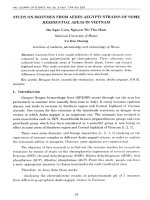
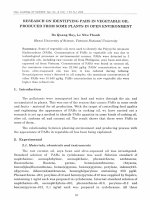
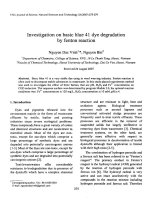
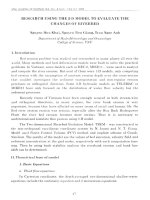

![DSpace at VNU: Corrigendum to ‘‘Nonlinear dynamic response of imperfect eccentrically stiffened FGM double curved shallow shells on elastic foundation’’ [Compos. Struct. 99 (2013) 88–96]](https://media.store123doc.com/images/document/2017_12/14/medium_vrh1513028470.jpg)

